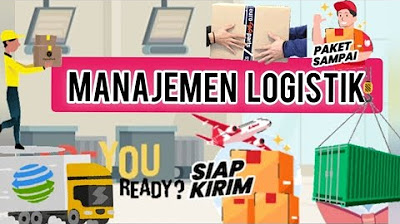What is Logistics & Logistics Management | What are Modes of Transport | How to select TransMode
Summary
TLDRThis video delves into the intricacies of logistics and logistics management, highlighting its pivotal role in supply chain efficiency. It explores various transportation modes like road, rail, sea, air, and pipeline, emphasizing their selection based on cost, speed, and cargo type. The video also covers key logistics functions such as warehousing, inventory management, order processing, and supply chain coordination, aiming to optimize delivery while minimizing costs.
Takeaways
- 🚚 Logistics is a core part of supply chain management, focusing on the efficient flow and storage of goods from origin to consumption.
- 🛠️ Key elements of logistics include transportation management, warehousing and distribution, inventory management, order processing and fulfillment, and supply chain coordination.
- 🚛 Transportation modes are selected based on cost, transit time, and cargo type, with road transport being flexible for short to medium distances.
- 🚞 Rail transport is efficient for long-distance haulage of bulk goods, often used for raw materials and heavy machinery.
- 🚢 Maritime transport, especially container shipping, is crucial for international trade, moving a wide range of goods over long distances between ports.
- ✈️ Air transport is the fastest mode for long-distance shipments, ideal for time-sensitive goods like perishables and high-value items.
- 💧 Pipeline transport is specialized for long-distance transportation of liquids and gases, offering efficiency and cost-effectiveness.
- 🌊 Waterway transport uses inland waterways for moving bulk commodities and heavy cargo, while coastal shipping moves goods along coastal routes.
- 🔄 Intermodal transportation combines different modes like rail and trucking for a cost-effective and environmentally friendly logistics solution.
- 📊 Logistics management aims to plan, coordinate, and optimize logistics activities to achieve operational efficiency and meet customer demands.
Q & A
What is logistics?
-Logistics is a fundamental component of supply chain management that involves the planning, implementation, and control of the efficient flow and storage of goods, services, and information from the point of origin to the point of consumption.
What are the key elements of logistics transportation management?
-Key elements include selecting appropriate transportation modes, routing shipments efficiently, managing carrier relationships, negotiating freight rates, warehousing and distribution, inventory management, order processing and fulfillment, and supply chain coordination.
Why is inventory management important in logistics?
-Inventory management is important to optimize inventory levels, balance supply and demand, minimize excess stock, ensure sufficient stock to meet customer orders, and implement control measures like ABC analysis, EOQ, and safety stock management.
What does order processing and fulfillment involve?
-Order processing and fulfillment involve processing customer orders accurately and efficiently, including order entry, picking, packing, and shipping, and implementing technology solutions like Warehouse Management Systems (WMS) and Order Management Systems (OMS).
What is logistics management and why is it strategic?
-Logistics management is the strategic process of planning, coordinating, and optimizing logistics activities within a supply chain to achieve operational efficiency and meet customer demands effectively.
What are the six primary modes of transport in logistics?
-The six primary modes of transport are road transport, rail transport, intermodal transportation, maritime transport, air transport, pipeline transport, and waterway transport.
How does road transport benefit logistics?
-Road transport, often via trucks, is widely used for short and medium distance shipments, offering flexibility in reaching remote locations and accommodating various types of cargo.
What is the role of rail transport in logistics?
-Rail transport is efficient for long-distance haulage of bulk goods and commodities, often used for transporting raw materials, minerals, and heavy machinery.
Why is maritime transport essential for international trade?
-Maritime transport, especially container shipping, is essential for international trade as it allows for the long-distance transportation of a wide range of goods between ports.
How does air transport differ from other modes in logistics?
-Air transport is the fastest mode for long-distance shipments and is commonly used for time-sensitive goods such as perishables, pharmaceuticals, and high-value products.
What factors influence the choice of the appropriate mode of transport in logistics?
-Factors influencing the choice of transport mode include distance, speed, cost, nature of goods, and geographic considerations such as terrain, weather conditions, and accessibility of routes.
Outlines

This section is available to paid users only. Please upgrade to access this part.
Upgrade NowMindmap

This section is available to paid users only. Please upgrade to access this part.
Upgrade NowKeywords

This section is available to paid users only. Please upgrade to access this part.
Upgrade NowHighlights

This section is available to paid users only. Please upgrade to access this part.
Upgrade NowTranscripts

This section is available to paid users only. Please upgrade to access this part.
Upgrade NowBrowse More Related Video

What is Logistics Management? Meaning, Importance, Basic Functions & Strategies - AIMS UK

Manajemen Logistik #1 Pengantar

MATERI KELAS XI MPLB "MANAJEMEN LOGISTIK"

(PART 1) : Aktifitas Manajemen Logistik

WHAT is the DIFFERENCE between SUPPLY CHAIN and LOGISTICS?

Module 4: Move It: Transportation and Logistics - ASU's W. P. Carey School
5.0 / 5 (0 votes)